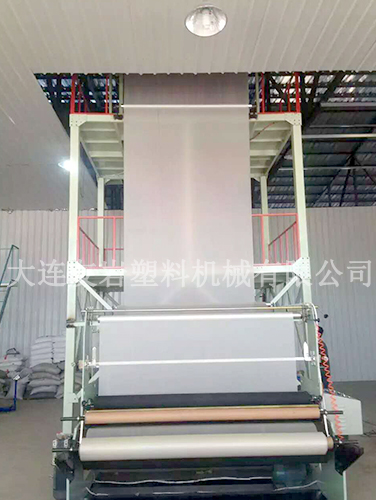Dalian Youyan Plastic Machinery Co., Ltd.
Couplet: Feng Manager
Phone/fax:086-0411-86260347
Hand:18624289888
13604263838
Mail box:21272059@qq.com
Network access:www.dlyouyan.com
Address: Chinese Lushunkou District of Dalian City, the three streams town (take Tuchengzi Dalian to Lushun Road westbound vehicle airport about 200 meters in front of about 100 meters)
As an important equipment in the plastic processing industry, the development and application of plastic blown film machines have had a profound impact on multiple fields. With the advancement of technology and changes in market demand, plastic blown film machines are developing towards high efficiency, energy saving, intelligence, multifunctionality, environmental protection, and high performance. In the future, plastic blown film machines will continue to play an important role in the plastic processing industry, promoting the progress and development of related industries.
In order to meet the needs of different customers, plastic blown film machines are gradually developing towards multifunctionality. A single device can produce films of various materials and thicknesses, improving the utilization rate and market competitiveness of the equipment. With the continuous emergence of new materials, plastic film blowing machines are also constantly adapting to the processing needs of new materials. For example, the application of environmentally friendly materials such as biodegradable plastics and bio based plastics promotes the innovation and development of blown film machine technology.
What are the main reasons for uneven film thickness on Dalian plastic blowing machines?
1、 Uneven die head temperature
Key impact: The die head is the core component of material extrusion film formation, and its temperature distribution directly determines the melt flow rate.
Performance: When the local temperature is too high, the flowability of the melt increases and the extrusion speed accelerates, resulting in a thinner film in the corresponding area; If the temperature is too low, the melt flow rate will be slow and the film will be thicker.
Common problem points:
The heating coil is damaged or unevenly distributed, resulting in inconsistent heating of various parts of the mold head.
Temperature control system malfunction (such as thermocouple failure), unable to accurately provide temperature data feedback.
2、 Unstable screw speed
Key impact: The screw speed directly affects the uniformity of material extrusion volume.
Performance: Fluctuations in rotational speed can cause fluctuations in the flow rate of molten material extruded per unit time, resulting in uneven longitudinal thickness of the film (along the direction of traction).
Common problem points:
Motor or transmission system (such as gearbox, belt) wear, resulting in speed fluctuations.
Electrical control system (such as frequency converter) malfunction, unable to stably output speed signal.
3、 Unreasonable inflation ratio and traction ratio
Key impact: The inflation ratio (the ratio of bubble diameter to die diameter) and traction ratio (the ratio of traction speed to extrusion speed) determine the degree of transverse and longitudinal stretching of the film.
Performance:
Excessive inflation ratio: Excessive transverse stretching of the film can easily lead to uneven transverse thickness, and even the appearance of "thin spots" or film breakage.
Insufficient inflation ratio: Insufficient transverse stretching, low transverse strength of the film, and scattered thickness distribution.
Improper traction ratio: Too fast or too slow traction speed can cause uneven longitudinal stretching, affecting the consistency of longitudinal thickness.
4、 Abnormal cooling system
Key impact: The airflow and wind speed distribution of the cooling air ring directly affect the cooling speed and shaping effect of the film.
Performance:
The air outlet of the wind ring is partially blocked or the angle is offset, causing the local cooling of the film to be too fast (thin thickness) or too slow (thick thickness).
When the cooling air volume is insufficient, the melt is excessively stretched before it is fully formed, which can easily cause thickness fluctuations.
5、 Poor plasticization of raw materials or uneven feeding
Key impact: The plasticization quality of raw materials and the stability of feeding directly determine the uniformity of the melt.
Performance:
The high moisture content or impurities in the raw materials result in local viscosity differences in the melt and inconsistent flow rates during extrusion.
The raw materials in the hopper are "bridged" (piled up into clusters), causing intermittent feeding and fluctuations in extrusion volume.
Plastic blown film machine is a widely used mechanical equipment in the production of plastic films, mainly used to produce various plastic films such as polyethylene (PE), polypropylene (PP), polyvinyl chloride (PVC) and other materials. Its working principle is to heat and melt plastic particles, extrude them through the die of a blown film machine, and then inflate them to form a plastic film with a certain thickness and width.
Thin films used in construction are mainly used for waterproofing, moisture-proof, thermal insulation, etc., such as waterproof films and moisture-proof films used in construction. Medical films are mainly used for packaging disposable medical devices, medical dressings, etc., requiring high cleanliness and sterility. Plastic film is also widely used in industries such as electronics, printing, advertising, etc., such as electronic component packaging, printing film, advertising film, etc.

